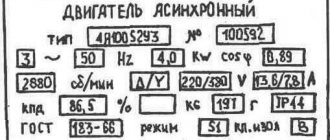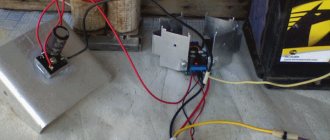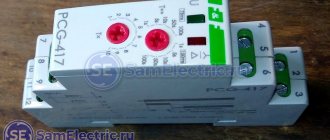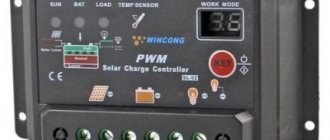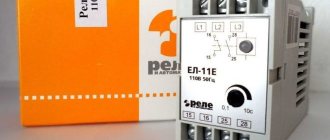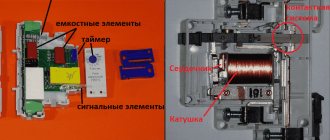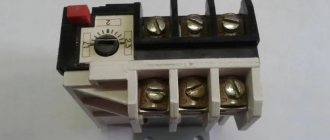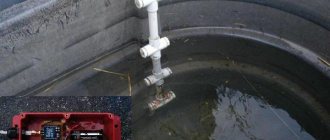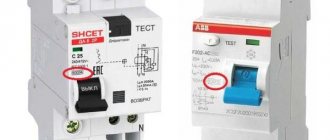Fire protection RCD is a conventional term that characterizes a switch with a differential current sensor and a mechanism for automatically shutting off the line in the event of dangerous leaks. This is the fire-fighting effect that is provided by any RCD. In this case, it is customary to subdivide residual current devices with a sensitivity of 10 - 30 mA to protect people from damage by leakage currents, and a sensitivity of 100 - 300 mA to protect against fire due to poor-quality or damaged insulation.
A fire protection RCD only protects against significant leakage currents that could cause a fire, and it is not intended to protect a person from electric shock.
In this review, we will consider in detail the features of using an RCD with a high setting in the apartment and home electrical supply system and schematic examples of connection in an electrical panel.
Functions of fire protection RCD
The main functions of a fire protection RCD include:
- Monitoring the condition of the input cable and its protection.
- Monitoring and protection of consumer lines in which differential protection is not installed.
- Analysis of the serviceability of the electrical circuit after the module for leakage current through the insulation.
- Redundancy (additional stage of protection) of downstream protections in the event of their failure and the continuing development of the emergency mode.
Let us dwell in more detail on the redundancy function, and note that since the RCD is a high-speed circuit breaker, when using conventional options with a setting of 100 - 300 mA, it will not be possible to ensure selectivity of series-connected residual current devices. Therefore, when the leakage current surges to a multiple value of the rated tripping differential current, in order to avoid simultaneous operation of devices connected in series, the main RCD must have a time delay - selectivity.
As fire-fighting (backup) devices, only selective RCDs of type “S” are used, which have a response time of 120-60 ms.
Causes of electrical fires
Causes of electrical fires may include:
- Heating of conductors (local or over an extended area) due to overload.
- Sparking at the site of poor electrical contact (in connections, at the terminals of electrical appliances and devices)
- Leakage from non-insulated sections of the circuit (in connection, branch and feed-through boxes, distribution boards, electrical devices).
- The burning of an electric arc in any part of the circuit caused by a short circuit current.
- Damage to cable insulation.
Damage to cable insulation can occur for the following reasons:
- Electrical - from overvoltage and overcurrent.
- Mechanical - impact, pressure, squeezing, bending, damage by a foreign body.
- Environmental influences - humidity, heat, radiation (ultraviolet), aging, chemical exposure.
The development of a short circuit from a leakage current, leading to a fire, occurs as follows:
- At the point of microdamage to the insulation, an extremely small point current begins to flow between energized conductors.
- Under the influence of humidity, pollution, and the penetration of dust over time, a conductive bridge is formed through which leakage current flows.
- As the insulation condition deteriorates, starting from a current value of approximately 1 mA, the conductive channel gradually becomes charred, a “carbon bridge” appears, and the current continuously increases.
- With a leakage current of 150 mA, which corresponds to a power of 33 W, there is a real danger of fire due to the heating of various flammable materials by the heat generated at the site of insulation damage.
Where is the fire protection RCD installed?
To increase the level of fire protection in case of short circuits to grounded parts, when the current value is insufficient to trigger the maximum current protection, it is recommended to install an RCD with an operating current of 100 mA at the entrance to the apartment (house). Devices with a setting of 300 mA are suitable for use in large facilities with many electrical panels and long cable lines.
The protective device is used in multi-level (multi-stage, cascade) circuits as the first stage of differential protection. It is placed in metering panels or in floor distribution panels after the meter. In this case, from the input machine, the phase and working neutral conductors are connected directly to the metering device (electricity meter). Next, after the metering device, a fire protection RCD is installed.
Giving a particular example, it can be noted that the use of a fire protection RCD is especially important in a wooden house that has two or more switchboards. With such a scheme, it is necessary to monitor both the input cable and the transit cables connecting the electrical panels that are not protected by group RCDs.
Species and types
Modern manufacturers offer a variety of types and types of RCDs. The two most popular types of units in terms of their internal design on the electrical goods market are electromechanical (do not depend on current) and electronic (depend on). Selective and fire-fighting devices are also distinguished.
Electromechanical
Electromechanical RCDs are widely used and are used in AC electrical circuits. What causes this? The fact is that when a leak is detected, such a device will work, preventing dire consequences even at the smallest voltage.
Operating principle of fire protection RCD
The operating principle of both fire-fighting and conventional RCDs is the same, based on the constant comparison of current vectors flowing through the phase and neutral conductors.
Operating principle of RCD
Let's take a closer look at this mechanism:
- In normal power supply mode, when the current vectors are equal, the induced magnetic fluxes from each wire, adding up in the magnetic circuit, destroy each other.
- When a leak occurs, the current in the working neutral conductor decreases by its value.
- The total magnetic flux changes in proportion to the leakage. It induces an electromotive force (EMF) in the magnetic circuit coil.
- Under the influence of EMF, the executive relay KL is activated. It completely removes power from the protected line.
RCDs for general use, with high speed, are designed to protect people from electric shock. A fire protection RCD has an increased response setting of 100 or 300 milliamps and, accordingly, lower response speed. This difference is clearly demonstrated in the following graph:
| Time-current characteristics of RCD | |
| 1 - time-current characteristic of RCD type “S” (IΔn = 300 mA) | |
| 2 - time-current characteristic of RCDs for general use (IΔn = 30 mA) | |
A fire protection RCD with a sensitivity of 100 - 300 mA will prevent a short circuit and prevent a fire by de-energizing the entire building until the current leak is eliminated. And such devices with rough cutoff primarily cover those sections of the network that are not protected by general-purpose RCDs.
Varieties by rated current
The most popular are modular devices from the ABB and Schneider Electric brands. There are possible types of rated electricity, which indicates its value that can pass an infinite number of times through the device: 16, 25, 40, 63 A. Therefore, the choice of device should be based precisely on these values of rated electricity.
There is no device that could provide 100% protection against overcurrents (short circuit, network overload), and this must be understood. That is why it is important that all RCDs are supplied with a circuit breaker with a rated current of less or the same strength. This is what the rules say, but I consider it advisable to install the RCD and the machine in such a way that the device has a larger rated current.
I will try to explain such “violations” of the rules in more detail. It is known that the machine can transmit electricity from 1 norm to 1.13 for a very long time, and only for an hour - 1.13-1.45. So, for example, if both the machine and the RCD are 25 A, the device transmits electricity in the amount of 36 A (25 * 1.45) per hour. Most likely, the device will simply burn out.
The rated electricity value can be found on the front of the device.
Well-known brands produce devices with the ratings indicated above, but Chinese manufacturers can produce 32 or 50A RCDs.
Fire safety of electrical installations
Let us highlight information from regulatory documents that regulate the use of RCDs to ensure fire safety of electrical installations of buildings, structures and structures:
| PUE 7. Rules for electrical installations. Edition 7 | 7.1.83. The total leakage current of the network, taking into account the connected stationary and portable electrical receivers in normal operation, should not exceed 1/3 of the rated current of the RCD. In the absence of data, the leakage current of electrical receivers should be taken at the rate of 0.4 mA per 1 A of load current, and the network leakage current at the rate of 10 μA per 1 m of phase conductor length. 7.1.84. To increase the level of fire protection in case of short circuits to grounded parts, when the current value is insufficient to trigger the maximum current protection, it is recommended to install an RCD with an operating current of up to 300 mA at the entrance to an apartment or individual house. 7.1.85. For residential buildings, when the requirements of clause 7.1.83 are met, the functions of the RCD according to clauses. 7.1.79 and 7.1.84 can be performed by one device with an operating current of no more than 30 mA. |
| Federal Law “Technical Regulations on Fire Safety Requirements” dated July 22, 2008 N 123-FZ | Article 82, paragraph 4. Power supply lines of premises of buildings, structures and structures must have protective shutdown devices that prevent the occurrence of a fire in the event of a malfunction of electrical receivers. The installation rules and parameters of residual current devices must take into account the fire safety requirements established in accordance with this Federal Law. |
| GOST R 53312-2009 SAFETY DISCONNECTION DEVICES Fire safety requirements. Test methods | p 6 The following buildings and structures are subject to equipping with residual current devices to prevent fires from electrical installations: Residential buildings:
|
| SP 31-110-2003 Design and installation of electrical installations of residential and public buildings | Appendix A.1.7. The use of RCDs for existing residential buildings with two-wire networks, where electrical receivers do not have protective grounding, is an effective means of increasing electrical safety. Triggering of an RCD during a short circuit to the housing in such networks occurs only when a differential current appears, that is, upon direct contact with the housing (connection to the “ground”). In accordance with this, the installation of an RCD can be recommended as a temporary measure to improve safety until a complete reconstruction is carried out. The decision to install an RCD must be made on a case-by-case basis after obtaining objective data on the condition of the electrical wiring and bringing the equipment into good condition. Appendix A.5.1. Single-family houses, country houses and garden houses must be subject to increased electrical safety requirements, which is due to their high energy saturation, extensive electrical networks and the specific operation of both the objects themselves and the electrical equipment, since in most cases the electrical equipment is not assigned to qualified, permanent operating services. |
Trademark
Speaking about the brand, we will essentially analyze the price-quality ratio. The fact is that there is an unspoken classification of all RCD manufacturers according to their territorial location - European models, Asian and Russian.
One way to spot a fake video:
Each of their products has its own characteristic features:
- Both a fire-fighting RCD and a device that protects people from electric shock produced in Europe will cost an order of magnitude more than models from Russia and China. But this price guarantees quality and reliability. It will not be amiss to know that some European companies, in addition to the main high-quality assortment, produce RCDs for the markets of other countries with the same reliability, but with reduced technical characteristics.
- Domestic manufacturers offer RCDs at a lower price than their counterparts from Europe, however, they meet all regulatory requirements of Russian standards. So far, Russian manufacturers' sales network is not so strong, and the devices themselves are not able to compete with Asians in price or with Europe in terms of quality.
- RCDs from Asian manufacturers are in greatest demand in the world. Some manufacturers from Asia enter into contracts with suppliers of products to the Russian market and in this case produce devices under the Russian brand.
Before choosing an RCD brand, decide what means you have for installing automatic protective equipment in an apartment or private house. Most preferred companies:
- Swiss "ABB";
- French Legrand and Schneider Electric;
- German "Siemens" and "Moeller".
Among domestic manufacturers, the most widely used products are:
- Kursky, average price and quality, the company gives a two-year guarantee for the RCDs produced, which indicates the reliability of the products;
- Moscow (“IEC”), products do not always receive positive reviews, however, the demand for it is high due to its low cost;
- Ulyanovsk, it is part of the group, which affects the quality of the products and, accordingly, the price;
- relatively young St. Petersburg, on the Russian market it represents the world-famous company “Schneider Electric”.
As for Chinese manufacturers, the RCDs they produce are a direct competitor to Russian devices. Price and quality are approximately at the same level, while the warranty period for Chinese goods is five years.
